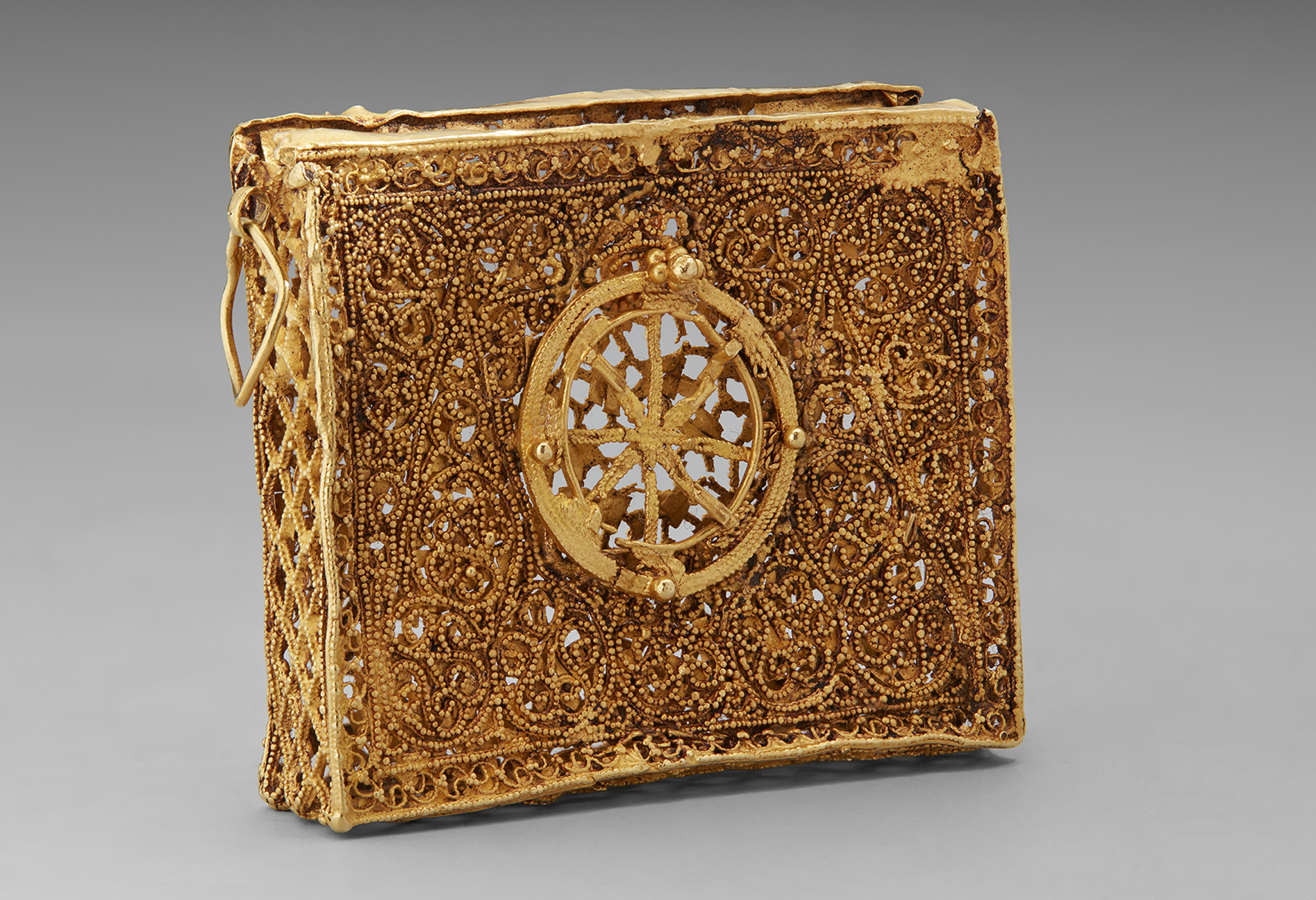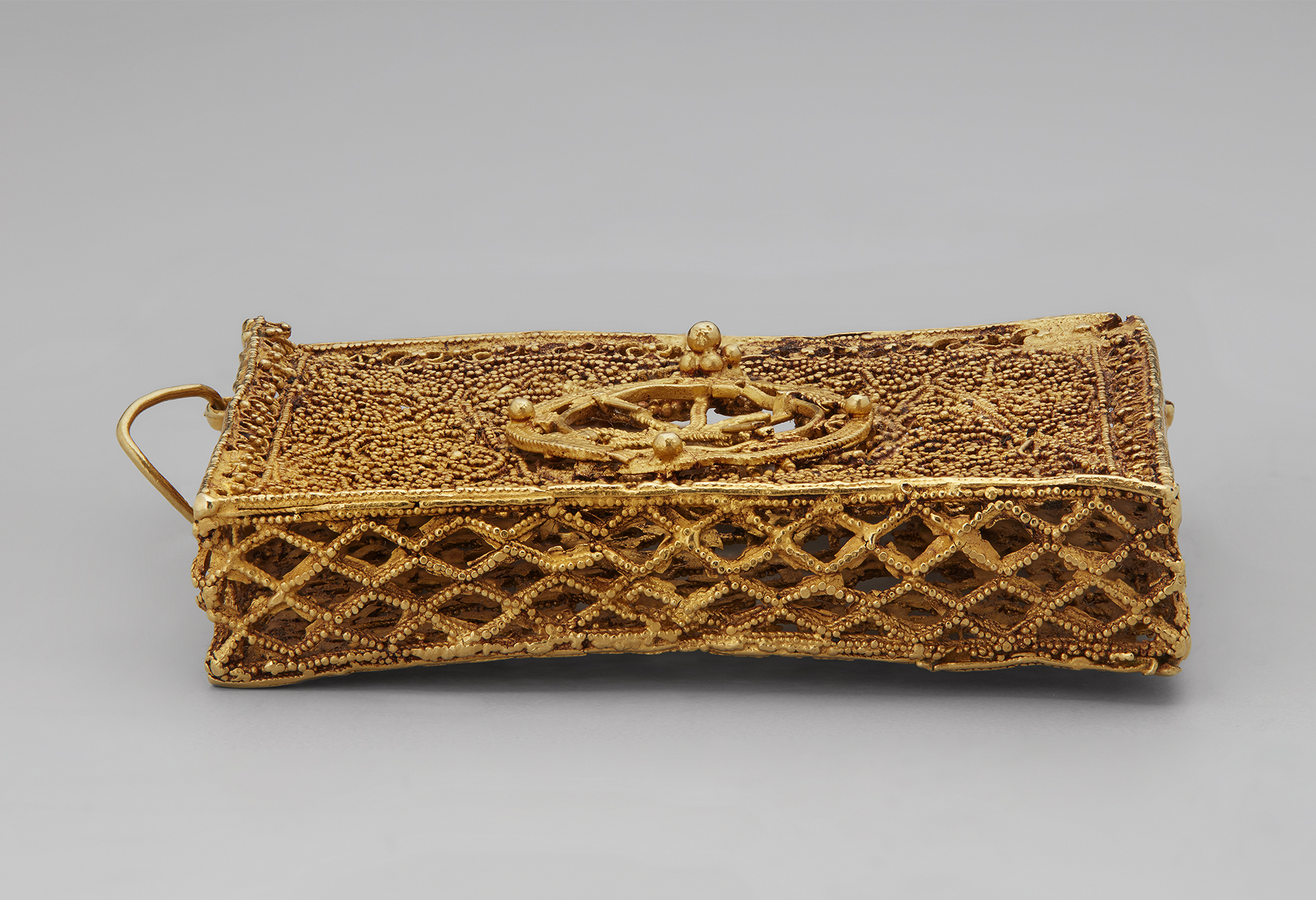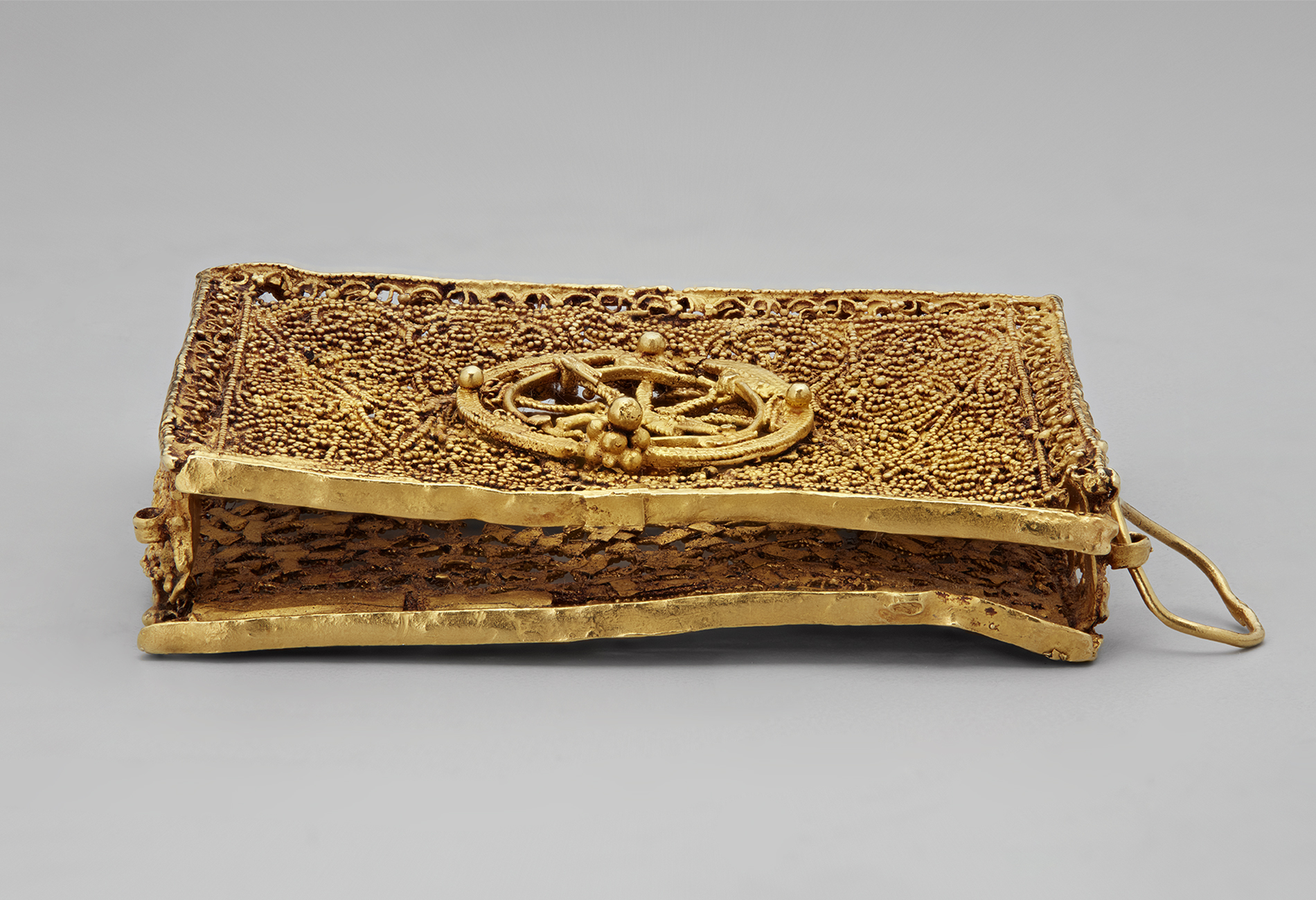Click on the image to zoom
Qur’an case
- Accession Number:AKM598
- Place:Egypt
- Dimensions:4.7 x 3.9 cm
- Date:11th century
- Materials and Technique:gold; filigree, granulation “rope wire”
This unique object is perhaps the only of its kind, though parallels in technique and style can be found in amulet boxes, beads, rings, and earrings from the Fatimid period (909–1171).[1] It was designed to hold a miniature Qur’an, which would have been worn as a talisman to protect the wearer. A single loop at the upper right of the case indicates how this object would have been suspended. The exquisite detail of its construction and ornamentation convey reverence for the holy text. It also reveals the mastery of Fatimid craftsmen, who were highly skilled at such techniques as filigree (forming patterns with golden wire) and granulation (wherein tiny grains or balls of gold are applied to a surface, either to fill in a design or to create a pattern).
Further Reading
One of the most triumphant dynasties of the medieval world, the Fatimids ruled from the seat of their empire in Cairo, their territory stretching across North Africa, and extending as far east as the Levant and Hijaz. Deriving their name from Fatima, daughter of the Prophet Muhammad, the Fatimid Empire maintained important trade relations within Africa, as well as with empires around the Indian Ocean and Mediterranean Sea. They formed an especially important relationship with the nearby Byzantine Empire (ca. 330–1453), and some Fatimid jewelled objects have very distinct links to Byzantine objects (see AKM594). The filigree and granulation on this object are also seen in contemporary Byzantine works.
The elaborate filigree on this Qur’an case demonstrates a style known as “rope and grain filigree,” [2] wherein artisans combined twisted fine wire known as “rope” with beaded granulation to create a complex and almost sculptural ornament. This openwork filigree is referred to as mushhabbak (latticework) in 12th-century trousseau lists from the Cairo Geniza documents, a trove of medieval documents found in the Ben Ezra Synagogue in Fustat, Egypt.[3]
Varying ornament patterns on each side of the case illustrates the goldsmith’s skill and creativity. The front is comprised of dense scrollwork around a central panel, which likely once held an inset, while the verso is comprised of repeating hexagonal motifs. While filigree remained an important element of Fatimid jewellery, the use of granulation eventually felt to the wayside, something that scholar Marc Rosenberg referred to as “the battle of granulation and filigree” in which the latter eventually prevailed.[4] This analysis suggests that this Qur’an case is among the earliest of Fatimid jewel types.
The Cairo Geniza reveals much about jewellery production during the Fatimid period, including prices, terminology, and details about these industries, much of which was staffed by Jewish craftsmen. The Fatimids obtained gold from a number of sources, including nearby mines in Nubia (modern-day Sudan) as well as in the Kingdom of Ghana. In other cases, Fatimid artisans melted down and repurposed metal from older jewellery, a likely fate for many Fatimid pieces which no longer exist today. The infamous looting of the treasury of Fatimid caliph al-Mustansir (1036–94) in circa 1070 resulted in an invaluable loss of many riches from this period.
— Courtney Stewart
Notes
[1] See L. A. Memorial Mayer Institute for Islamic Art (Inventory Number J22); National Museum of Damascus A.1054; AKM 618, 595, 596.
[2] Michael Spink and Jack Ogden, The Art of Adornment; Jewellery of the Islamic Lands. Part I (London: Nour Foundation, 2013), 125.
[3] Marilyn Jenkins-Madina, The Glory of Byzantium (New York: The Metropolitan Museum of Art, 1997), 419–20), quoting Goitein, A Mediterranean Society: The Jewish Communities of the Arab World As Portrayed in the Documents of the Cairo Geniza, vol. 4, 211–12.
[4] Marilyn Jenkins, “Fatimid Jewelry, Its Subtypes and Influences,” Ars Orientalis, vol. 18 (1988), 40, quoting Marc Rosenberg, “Abteilung: Granulation,” Geschichte der Goldschmiedekunst auf Technischer Grundlage, vol.3 (Frankfurt, 1918), 96–103.
References
Barrucand, Marianne. L'egypte Fatimide: Son Art Et Son Histoire : Actes Du Colloque Organisé À Paris Les 28, 29 Et 30 Mai 1998. Paris: Presses de l'université de Paris-Sorbonne, 1998, 197–217. ISBN: 9782840501626
Bloom, Jonathan M. Arts of the City Victorious. New Haven and London: Yale University Press, 2007. ISBN: 9780300135428
Ekhtiar, Maryam, Sheila R. Canby, Navina Haidar, and Priscilla P. Soucek, eds. Masterpieces from the Department of Islamic Art in The Metropolitan Museum of Art, 1st ed. New York: The Metropolitan Museum of Art, 2011. ISBN 9781588394347
Evans, Helen, and William D. Wixom, ed. The Glory of Byzantium. New York: The Metropolitan Museum of Art, 1997. ISBN: 9780870997778
Goitein, Shelomoh D. A Mediterranean Society: The Jewish Communities of the Arab World As Portrayed in the Documents of the Cairo Geniza. Berkeley: University of California Press, 1999. ISBN: 9780520221581
Ḥason, Rachel. Early Islamic Jewellery: L. A. Memorial Mayer Institute for Islamic Art. Jerusalem: L. A. Mayer Memorial Institute for Islamic Art, 1987.
Jenkins-Madina, Marilyn, and Manuel Keene. Islamic Jewelry in the Metropolitan Museum of Art. New York: Metropolitan Museum of Art, 1983. ISBN: 9780870993268
Jenkins-Madina, Marilyn. "Fatimid Jewelry, Its Subtypes and Influences." Ars Orientalis, vol. 18 (1988), 40, 45, ill. figs. 51, 5b.
O'Kane, Bernard. The Treasures of Islamic Art in the Museums of Cairo. Cairo: American University in Cairo Press, 2006. ISBN: 9789774248603
Rosenberg, Marc. “Abteilung: Granulation.” Geschichte der Goldschmiedekunst auf Technischer Grundlage, vol. 3. Frankfurt: 1918, 96–103.
Spink, Michael and Jack Ogden. The Art of Adornment; Jewellery of the Islamic Lands. Part I and Part II. London: Nour Foundation, 2013. ISBN: 9781874780861
Trésors Fatimides du Caire Exposition Présentée à l'Institut du Monde Arabe du 28 Avril au 30 Aout 1998. Paris: Institut du Monde Arabe, 1998. ISBN: 9782843060113
Note: This online resource is reviewed and updated on an ongoing basis. We are committed to improving this information and will revise and update knowledge about this object as it becomes available.








